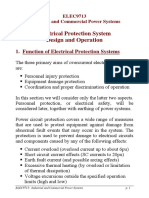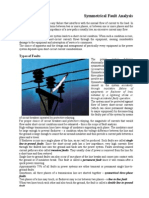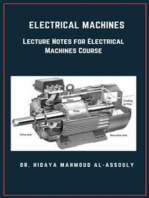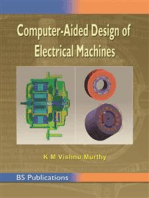Symmetrical Components
Uploaded by
Alcibiades MaytaSymmetrical Components
Uploaded by
Alcibiades MaytaSymmetrical Components
Symmetrical Component Analysis
Synthesis of Unsymmetrical
Phases from Their Symmetrical
Components
The Symmetrical Components of
Unsymmetrical Phasors
Phase Shift of Symmetrical
Components in Y or Y
Transformer Banks
Power in Terms of Symmetrical
Components
Symmetrical Components
Unsymmetrical Series
Impedance
Sequence Impedance and
Sequence Network
Sequence Networks of
Unloaded generators
Sequence Network
Zero-Sequence Network
Symmetrical Component Analysis
Goal :
Symmetrical component analysis is a very useful tool
for dealing with unbalanced three-phase faults.
Synthesis of Unsymmetrical Phases from
Their Symmetrical Components
1
An unbalanced system of n related phasors can be resolved into
n systems of balanced phasors called the symmetrical components
of the original phasors. The n phasors of each set of components
are equal in lengths , and the angles between adjacent phasors of
the set are equal.
by C.L Fortescue , 1918
Synthesis of Unsymmetrical Phases from
Their Symmetrical Components
2
(1) Positive- sequence components
a1
b1
c1
(2) Negative-sequence components
c2
a2
b2
1. For positive- sequence
2. For negative-sequence
components
components
Synthesis of Unsymmetrical Phases from
Their Symmetrical Components
3
(3) Zero-sequence components
Va 0
Vb 0
Vc 0
0 For zero-sequence components
Synthesis of Unsymmetrical Phases from
Their Symmetrical Components
4
Va
Va 0
Va Va1 Va 2 Va 0
Va 2
Vc 2
Vc1
Vc 0
Vc
Vb
Vb 0
Va 1
Vb 2
Vb1
Vb Vb1 Vb 2 Vb 0
Vc Vc1 Vc 2 Vc 0
Synthesis of Unsymmetrical Phases from
Their Symmetrical Components
5
Use a to designate the operator that causes a rotation of 1200 in the
counterclockwise direction ,
a
a2
a 11200 0.5 j 0.866
a 1240 0.5 j 0.866
2
1, a 3
1, a 3
a 3 13600 1
a2
The Symmetrical Components of
Unsymmetrical Phasors
1
Vb1 a 2Va1 , Vc1 aVa1
Vb 2 a Va 2 , Vc 2 a 2Va 2
Vb 0 Va 0 , Vc 0 Va 0
c2
b1
a1
c1
a2
b2
The Symmetrical Components of
Unsymmetrical Phasors
2
Va Va1 Va 2 Va 0
Vb Vb1 Vb 2 Vb 0 a 2Va1 aVa 2 Va 0
Vc Vc1 Vc 2 Vc 0 a Va1 a 2Va 2 Va 0
Va 1
V 1
b
Vc 1
1
a2
a
1 Va 0
a Va1
a 2 Va 2
The Symmetrical Components of
Unsymmetrical Phasors
3
1
A 1
1
Va 0
1
V 1 1
a1 3
Va 2
1
1
a2
a
1
a
a2
1
a
a 2
A1
1
1
1
3
1
1
a
a2
1 Va
a 2 Vb
a Vc
* When three phase phasors are balanced , only the
positive-sequence component exists .
1
a 2
a
The Symmetrical Components of
Unsymmetrical Phasors
4
1.Sequence component representation of L-L voltage
Vab 0
1
V 1 1
ab1 3
Vab 2
1
1
a
a2
1 Vab
a 2 Vbc
a Vca
2.Sequence component representation of current
I a0
1
I 1 1
a1 3
I a 2
1
1
a
a2
1 I a
a 2 I b
a I c
The Symmetrical Components of
Unsymmetrical Phasors
5
1
(Va Vb Vc )
3
1
Vab 0 (Vab Vbc Vca )
3
1
I a0 (I a Ib Ic )
3
Va 0
No zero-sequence components exist if the sum of the three
phasors is zero.
The Symmetrical Components of
Unsymmetrical Phasors
6
Va 0
1
(Va Vb Vc )
3
Va 0 0
When 3 is balanced
Va 0 0
When
* If
(Va Vb Vc ) 0
Va 0 0 then 3 is unbalanced.
* Unbalanced
does not guarantee
Va 0 0 .
The Symmetrical Components of
Unsymmetrical Phasors
7
Vab 0
1
(Vab Vbc Vca )
3
Vab 0 is always zero
whether the three phase system
is balanced or not.
(Vab Vbc Vca ) is always zero (form closed loop)
b
a
c
The Symmetrical Components of
Unsymmetrical Phasors
8
Ia
1
I a0 (I a Ib Ic ) 0
3
Ib
( ungrounded Y )
Ic
Ia
Ib
Ic
Ia
Ib
Ic
In
1
I a0 (I a Ib Ic ) 0
3
( I a I b I c ) 3I a 0 I n
Y with a path to neutral
1
I a0 (I a Ib Ic ) 0
3
connected
VECTOR
SOFTWARE
The Symmetrical Components of
Unsymmetrical Phasors
9
One conductor of a three-phase line is open. The current flowing to the
example :
-connected load through line a is 10 A. With the current in line a as
reference and assuming that line c is open, find the symmetrical components
of the line currents
I a 100 0 amp
The line currents are :
I b 10180 amp
0
b
c
I a 100 0 A
I b 10180 0 A
Ic 0 A
Z
Ic 0
The Symmetrical Components of
Unsymmetrical Phasors
10
I a0
1
(1000 101800 0) 0 Since there no neutral current involved , I a 0
3
should be zero .
1
(1000 101800 1200 0)
3
5 j 2.89 5.78 30 0 A
1
(1000 101800 2400 0)
3
I a1
I a2
5 j 2.89 5.78 30 0 A
I b1 5.78 150 0 A
I c1 5.78 90 0 A
I b 2 5.78 150 0 A
I c 2 5.78 90 0 A
I b0 0
I c0 0
Phase Shift of Symmetrical Components
in Y or Y Transformers Banks
1
The American standard for designating terminal H1 and X 1 on Y or Y
transformer requires that the positive-sequence voltage drop from H1 to
neutral leads the positive-sequence voltage drop from X 1 to neutral by 300 ,
regardless of whether the Y or winding is on the high tension side .
Similarly, the positive-sequence voltage drop from H 2 to neutral leads the
voltage drop from X 2 to neutral by
300
and the positive-sequence voltage
drop from H 3 to neutral leads the voltage drop from X 3 to
neutral by
300
Phase Shift of Symmetrical Components
in Y or Y Transformers Banks
2
Example :
H1
X1
H1
X1
H2
X2
H3
B
C
H2
X2
X3
H3
X3
VA1 leads Vb1 by 300
VA1 leads Va1 by 300
Phase Shift of Symmetrical Components
in Y or Y Transformers Banks
3
The American standard for designating terminal H1 and X 1 on Y or Y
transformer requires that the negative-sequence voltage drop from H1 to
neutral lags the negative-sequence voltage drop from X 1 to neutral by 300 ,
regardless of whether the Y or winding is on the high tension side .
Similarly, the negative-sequence voltage drop from H 2 to neutral lags
the voltage drop from X 2 to neutral by 300 and the negative-sequence
voltage drop from H 3 to neutral lags the voltage drop from X 3 to neutral
by
300
Phase Shift of Symmetrical Components
in Y or Y Transformers Banks
4
Example :
H1
X1
H1
X1
H2
X2
H3
B
C
H2
X2
X3
H3
X3
(a)
VA2 lags Vb 2 by 30
(b) VA2 lags Va 2 by 30
Phase Shift of Symmetrical Components
in Y or Y Transformers Banks
5
A
H1
X1
H2
H3
X2
X3
Y
B1
b1
c1
Va1 leads VA1 by 900
A1
C1
VA1 leads Vb1 by 30
a2
C2
A2
a1
Va 2 lags VA2 by 900
b2
B2
c2
VA2 lags Vb 2 by 300
Phase Shift of Symmetrical Components
in Y or Y Transformers Banks
6
Example 11.7. The resistive Y-connected load bank of Example 11.2 is supplied from the low-voltage
Y-side of a Y- transformer. The voltages at the load are the same as in that example. Find the line
voltages and currents in per unit on the high-voltage side of the transformer.
I (1) a 0.9857 43 .60 per unit
I ( 2 ) a 0.2346 250 .30 per unit
V (1) an 0.985743.60 per unit(line to neutral voltage base)
V ( 2 ) an 0.2346 250 .30 per unit(line to neutral voltage base)
V (1) A 0.9857 43 .60 30 0 0.9857 73 .60 0.2785 j 0.9456
V ( 2 ) A 0.2346 250 .30 30 0 0.2346 220 .30 0.1789 j 0.1517
VA V (1) A V ( 2 ) A 0.0994 j 0.7939 0.882 .80 per unit
V (1) B a 2V (1) A 0.9857 46 .40 0.6798 j 0.7138
Phase Shift of Symmetrical Components
in Y or Y Transformers Banks
7
V ( 2 ) B a 2V ( 2 ) A 0.2346 19 .70 0.2209 j 0.0791
VB V (1) B V ( 2 ) B 0.9007 j 0.7929 1.20 41 .40 per unit
V (1)C a 2V (1) A 0.9857 193 .60 0.9581 j 0.2318
V ( 2 )C a 2V ( 2 ) A 0.2346 100 .30 0.0419 j 0.2318
VC V (1) C V ( 2 )C 1.0 j 0 1.0180 0 per unit
VAB VA V B 0.0994 j 0.7939 0.9007 j 0.7929 0.8013 j1.5868
1.78 116 .80 per unit(line neutral voltagae base)
1.78
116 .80 per unit(line to line voltagae base)
3
Phase Shift of Symmetrical Components
in Y or Y Transformers Banks
8
VBC VB V C 0.9007 j 0.7939 1.0 1.9007 j 0.7939
2.06 22 .70 per unit(line neutral voltagae base)
2.06
22 .70 1.19 22 .70 per unit(line to line voltagae base)
3
VCA VC V A 1.0 0.0994 j 0.7939 1.0994 j 0.97939
1.356 215 .80 per unit(line neutral voltagae base)
1.356
215 .80 0.783 215 .80 per unit(line to line voltagae base)
3
I A 0.80 82 .80 per unit
I B 1.20 41 .40 per unit
I C 1.0180 0 per unit
Phase Shift of Symmetrical Components
in Y or Y Transformers Banks
9
H1
X1
H1
X1
H2
X2
H3
B
C
H2
X2
X3
H3
X3
(a)
(1)
V (1) A leads V a
by 300
(b) V (1) A leads V (1) a by 300
Figure 11.23
labeling of lines connected to a three-phase Y- transformer.
Power in terms of Symmetrical Components
S P jQ Va I * a Vb I *b Vc I * c
Va
S Vb
Vc
Ia
*
I AV T AI
012
012
b
Ic
V012 AT A* I 012 3V012 I 012
T
3Va 0
Va1
I a0
Va 2
I
a
1
I a2
3(Va 0 I * a 0 Va1 I * a1 Va 2 I * a 2 )
, AT A* 3I
Unsymmetrical Series Impedance 1
a
Za
Ia
b
c
Ib
Zb
a'
Z ab
Z ca
Z c Z ac
Ic
Vaa '
Vbb '
V '
cc
Za
ba
Z ca
Z ab
Zb
Z cb
b'
c'
Z ac I a
I
Z bc
b
Zc
Ic
Unsymmetrical Series Impedance 2
Vaa ' 0 Z a
AVbb' 1 Z ba
V ' Z ca
cc 2
Z ab
Vaa ' 0
Za
1
V
A
Z
bb ' 1
ba
V '
Z ca
cc 2
Z ab
Zb
Z cb
Zb
Z cb
Z ac I a 0
Z bc A I a1
Z c I a 2
Z ac I a 0
Z bc A I a1
Z c I a 2
Unsymmetrical Series Impedance 3
Z 012 A1ZA
( Z s 0 2 Z M 0 )
( Z s1 2 Z M 1 )
( Z s 2 2 Z M 2 )
( Z s 2 2Z M 2 )
( Z s 0 2Z M 0 )
( Z s1 2 Z M 1 )
( Z s1 2 Z M 1 )
( Z s 2 2 Z M 2 )
( Z s 0 2 Z M 0 )
Where
1
Z s0 (Z a Zb Z c )
3
1
Z s1 ( Z a aZ b a 2 Z c )
3
1
Z s 2 ( Z a a 2 Z b aZ c )
3
1
( Z bc Z ca Z ab )
3
1
Z M 1 ( Z bc aZ ca a 2 Z ab )
3
1
Z M 2 ( Z bc a 2 Z ca aZ ab )
3
ZM 0
Unsymmetrical Series Impedance 4
Vaa ' 0 ( Z s 0 2 Z M 0 ) I a 0 ( Z s 2 2 Z M 2 ) I a1 ( Z s1 2 Z M 1 ) I a 2
Vaa ' 1 ( Z s1 2 Z M 1 ) I a 0 ( Z s 0 2 Z M 0 ) I a1 ( Z s 2 2 Z M 2 ) I a 2
Vaa ' 2 ( Z s 2 2 Z M 2 ) I a 0 ( Z s1 2 Z M 1 ) I a1 ( Z s 0 2 Z M 0 ) I a 2
Unsymmetrical Series Impedance 5
Case 1. If no coupling , Z ij ( i j ) 0
then
ZM 0 ZM1 ZM 2 0
Vaa ' 0 Z s 0 I a 0 Z s 2 I a1 Z s1 I a 2
1
1
1
I a 0 (Z a Z b Z c ) I a1 (Z a a 2 Z b aZc ) I a 2 (Z a aZb a 2 Z c )
3
3
3
Vaa ' 1 Z s1 I a 0 Z s 0 I a1 Z s 2 I a 2
1
1
1
I a 0 ( Z a aZb a 2 Z c ) I a1 ( Z a Z b Z c ) I a 2 ( Z a a 2 Z b Z c )
3
3
3
Vaa ' 2 Z s 2 I a 0 Z s1 I a1 Z s 0 I a 2
1
1
1
I a 0 ( Z a a 2 Z b aZc ) I a1 ( Z a aZb a 2 Z c ) I a 2 ( Z a Z b Z c )
3
3
3
Unsymmetrical Series Impedance 6
Case 2 . If
1.
Z a Zb Zc
2.
Z ij ( i j ) 0
Vaa ' 1 I a1 Z a
Complete transportation assumed
Vaa ' 2 I a 2 Z a
Vaa ' 0 I a 0 Z a
Symmetrical components of unbalanced currents flowing in a balanced-
load
or in balanced series impedances produce voltage drops of the same sequence ,
provided no coupling exists between phases.
If the impedances are unequal, the voltage drop of any one sequence is dependent on the
current of all three sequences.
If coupling such as mutual inductance exists among the three impedances, then the
formula will become more complicated.
Unsymmetrical Series Impedance 7
Assume:
1. No coupling
2.
Z a Zb Zc
Positive-sequence currents produce positive-sequence voltage drops.
Negative-sequence currents produce negative sequence voltage drops.
zero-sequence currents produce zero-sequence voltage drops.
Sequence Impedance and Sequence Network 1
The impedance of circuit when positive- sequence
current alone are flowing is called positive-sequence
impedance.
The impedance of circuit when negative-sequence
currents alone are flowing is called negative
sequence impedance.
When only zero-sequence currents are present, the
impedance is called zero sequence impedance.
Sequence Impedance and Sequence Network 2
The single-phase equivalent circuit composed of the impedance to
current of any one sequence only is called the sequence network.
Positive-sequence network contains positive sequence current and
positive sequence impedance only.
Negative-sequence network contains negative sequence current
and negative sequence impedance only.
Sequence Impedance and Sequence Network 3
Zero-sequence network contains zero sequence current and
zero sequence impedance only.
Sequence network carrying the individual currents
and I a 0 are interconnected to represent various
unbalanced fault condition.
I a1 , I a 2
Sequence Impedance and Sequence Network 4
Sequence Impedance of Various Devices
Positive
Negative
Zero
Line
same
same
different
Transformer
same
same
same
Machine
different *
different *
different
* Usually they are assumed to be the same
Sequence Networks of Unloaded Generators 1
a
Ia
Zn
In
- +
Ec
The generator voltage ( Ea , Eb , Ec )
Ea
are of positive sequence only,
Eb
+
since the generator is designed
to supply balanced three-phase
Ib
Ic
voltage.
Sequence Networks of Unloaded Generators 2
a
Reference
I a1
- Ea
- - Eb
+ Ec +
Z1
Z1
Ea
Z1
Va1 Ea I a1 Z1
Va 1
Z1
I b1
I a1
Ia
Positive-sequence
network
Reference
Z2
Z2
c
Z2
Ia2
Ib2
b I
c2
Va 2 I a 2 Z 2
Va 2
Z2
Ia2
Negative-sequence
network
Sequence Networks of Unloaded Generators 3
I c1
Zn
3I a 0
Z g0
Z g0
I a0
Z g0
c
Reference
I a0
3Z n
Z g0
I a0
Zero-sequence
network
Z n only appears in the zero-sequence
network
I a 0 ( Z g 0 3Z n )
Va 0
Z0
b I
a0
Va 0 I a 0 Z 0
3I a 0 I n
Sequence Networks of Unloaded Generators 4
Example 11.6. A salient-pole generator without dampers is rated 20 MVA, 13.8kV and has a
direct=axis subtransient reactance of 0.25 per unit. The negative-and-zero-sequence reactance
are, respectively, 0.35 and 0.10 per unit. The neutral of the generator is solidly grounded. With
0
the generator operating unloaded at rated voltage with Ean 1.00 per unit , a single line-to-
ground fault occurs at the machine terminals, which then have per-unit voltages to ground,
Va 0
Vc 1.013 102 .25 0
Vb 1.013 102 .25 0
Determine the subtransient current in the generator and the line-t0-line voltages for subtransient
conditions due to the fault.
a
Ia
Zn
Ia In
- n
- + Ecn
Ean
Figure 11.15
Ebn
+
b
Ib 0
Ic 0
Sequence Networks of Unloaded Generators 5
Figure 11.15 shows the line-to-ground fault of phase a of the machine.
Vb 0.215 j 0.990 per unit
Vc 0.215 j 0.990 per unit
Va ( 0)
1 1
( 0) 1
Vb 3 1 a
V ( 0)
1 a 2
c
( 0)
1
0
0.143 j 0
a 2 0.215 j 0.990 0.643 j 0 per unit
a 0.215 j 0.990 0.500 j 0
V ( 0) a
( 0.143 j 0)
j1.43 per unit
Z go
j 0.10
Sequence Networks of Unloaded Generators 6
(1)
( 2)
Ean V (1) a
(1.0 j 0) (0.643 j 0)
j1.43 per unit
Z1
j 0.25
V ( 2)a
( 0.500 j 0)
j1.43 per unit
Z2
j 0.35
There, the fault current into the ground is
I a I ( 0 ) a I (1) a I ( 2 ) a 3I ( 0 ) a j 4.29
The base current is 20 ,000 ( 3 13 .8) 837 A and so the subtransient current in line a is
I a j 4.29 837 j 3,590 A
Sequence Networks of Unloaded Generators 7
Line-to-line voltage during the fault are
Vab Va Vb 0.215 j 0.990 1.0177 .70 per unit
Vbc Vb Vc 0 j1.980 1.980 270 0 per unit
Vca Vc Va 0.215 j 0.990 1.0177 .70 per unit
Vab 1.01
13 .8
77 .70 8.0577 .70 kV
3
Vbc 1.980
Vca 1.01
13 .8
270 0 15 .78 270 0 kV
3
13 .8
102 .30 8.05102 .30 kV
3
Sequence Networks of Unloaded Generators 8
Before the fault the line voltages were balanced and equal to 13.8kV. For comparison with the line
voltages after the fault occurs, the prefault voltages, with Van Ean as reference, are given as
Vab 13 .830 0 kV
Vbc 13 .8270 0 kV
Vca 13 .8150 0 kV
Figure 11.6 shows phasor diagrams of prefault and postfault voltages.
b
Vab
a
Van
Vab
a
n
Vbc
Vca
Vbc
Vca
c
(a) Prefault
(b) Postfault
Figure 11.6
Sequence Networks of Unloaded Generators 9
The positive-sequence diagram of a generator is
composed of an emf in series with the positive-sequence
impedance of the generator.
The negative and zero-sequence diagrams contain no
emfs but include the negative and zero-sequence
impedances of the generator respectively.
Sequence Networks
The matching reactance in positive-sequence network is the subtransient ,transient,
or synchronous reactance, depending of whether subtransient , transient, or
steady- state condition are being studied.
The reference bus for the positive and negative sequence networks is the neutral
of the generator. So for as positive and negative sequence components are
concerned , the neutral of the generator is at ground potential even if these is Z n
connection between neutral and ground.
The reference bus for the zero sequence network is the ground (not necessary
the neutral of the generator).
Sequence Networks
Convert a positive sequence network to a negative sequence
network by changing, if necessary, only the impedance
that represent rotating machine , and by omitting the emf.
The normal one-line impedance diagram plus the induced emf is the
positive sequence network.
Three-phase generators and motors have internal voltage of positive
sequence only.
Example of Positive and Negative-Sequence Network 1
Example: Draw the positive and negative-sequence networks
for the system described as below . Assume that the
negative-sequence reactance of each machine is
equal to its subtransient reactance .Omit resistance.
T1
T
l
M1
n
r
M2
Example of Positive and Negative-Sequence Network 2
j 0.0815
j 0.0857
m
k
l
j 0.02
j 0.0915
n
j 0.2745
j 0.5490
+
Eg
E m1
(Positive)
Em 2
Reference bus
j 0.02
k
j 0.0857
j 0.5490
j 0.2745
p
l
j 0.0815
n
j 0.0915
(Negative)
Zero sequence Network
1 . Zero-sequence network currents will flow only if a return path exists.
2 . The reference bus of the zero-sequence network is the ground.
Reference
Zero sequence Network
R
Z
I n 3I a 0
Nn
3Z n
N
I a0
R
Z
Zero sequence Network
Zero-sequence equivalent circuit of three phase transform banks.
p
p
Zero-Sequence
Equivalent Circuit
Connection Diagrams
Symbols
Q
Z0
Reference bus
p
Q
Z0
Reference bus
Zero sequence Network
Symbols
4
Zero-Sequence
Equivalent Circuit
Connection Diagrams
p
Q
p
Z0
Reference bus
p
p
Q
p
Q
Z0
Reference bus
Zero sequence Network
Symbols
Zero-Sequence
Equivalent Circuit
Connection Diagrams
p
p
Z0
Reference bus
Zero sequence Network
Example:
Zn
3Z n
Q
Z g0
M
P
(Zero-Sequence)
Zero sequence Network
Q
Z g1
E g1
SEQUENCE
Zg2
NETWORK
E g1
SOFTWARE
(Positive-Sequence)
M
N
P
Q
S
(Negative-Sequence)
Zero sequence Network
Example 11.9. Draw the zero-sequence network for the system described in Example 6.1. Assume
zero-sequence network for the generator and motors of 0.05 per unit. A current-limiting reactor of
0.4
is in each of the each of the neutrals of the generator and the large motor. The zero-sequence
reactance of the transmission line is 1.5 km
Generator:
X 0 0.05 per unit
300 13.2 2
)(
) 0.0686 per unit
200 13.8
Motor 1:
X 0 0.05(
Motor 2:
X 0 0.05(
300 13.2 2
)(
) 0.1372 per unit
100 13.8
( 20 ) 2
Base Z
1.333
300
(13 .8) 2
Base Z
0.635
300
Zero sequence Network
3Z n 3(
0.4
) 0.900 per unit
1.333
3Z n 3(
Z0
0.4
) 1.890 per unit
0.635
1.5 64
0.5445 per unit
176.3
The zero-sequence network is shown in Fig. 11.28
k
j0.5445
j0.0857
j0.0915
n
j 0.05
j0.0686
j0.1372
j 0.900
j1.890
reference
You might also like
- 1039.5Kwp PV Solar Solar System (PVS) 250Kw / 500Kwh Battery Energy Storage System (Bess)No ratings yet1039.5Kwp PV Solar Solar System (PVS) 250Kw / 500Kwh Battery Energy Storage System (Bess)1 page
- Symmetrical Components & Faults CalculationsNo ratings yetSymmetrical Components & Faults Calculations26 pages
- Simulation of Some Power System, Control System and Power Electronics Case Studies Using Matlab and PowerWorld SimulatorFrom EverandSimulation of Some Power System, Control System and Power Electronics Case Studies Using Matlab and PowerWorld SimulatorNo ratings yet
- ELEC4100 Tutorial 7 Symmetrical Components Soln100% (1)ELEC4100 Tutorial 7 Symmetrical Components Soln5 pages
- Voltage Stability: (Definition and Concept)No ratings yetVoltage Stability: (Definition and Concept)33 pages
- Power System Protection: Fault AnalysisNo ratings yetPower System Protection: Fault Analysis41 pages
- KE47503 High Voltage Chapter 8 Part 1 - Overvoltage Phenomenon and Insulaton Coordination in Electrical Power SystemsNo ratings yetKE47503 High Voltage Chapter 8 Part 1 - Overvoltage Phenomenon and Insulaton Coordination in Electrical Power Systems40 pages
- Power System Stability Course Notes PART-1: Dr. A.Professor Mohammed Tawfeeq Al-Zuhairi100% (1)Power System Stability Course Notes PART-1: Dr. A.Professor Mohammed Tawfeeq Al-Zuhairi8 pages
- EE4003 Power Systems II: Course SyllabusNo ratings yetEE4003 Power Systems II: Course Syllabus24 pages
- Tutorial On Symmetrical Components: Part 2: Answer KeyNo ratings yetTutorial On Symmetrical Components: Part 2: Answer Key23 pages
- Three Phase Fault Analysis With Auto Reset Technology On Temporary Fault or Remain Tripped Otherwise50% (2)Three Phase Fault Analysis With Auto Reset Technology On Temporary Fault or Remain Tripped Otherwise4 pages
- Negative Sequence Diffrerential ProtectionNo ratings yetNegative Sequence Diffrerential Protection17 pages
- Distance Protection With Parallel Compensation: N 1. Explanation of The Term Parallel LineNo ratings yetDistance Protection With Parallel Compensation: N 1. Explanation of The Term Parallel Line14 pages
- Protection of Power Systems With Distributed GenerationNo ratings yetProtection of Power Systems With Distributed Generation35 pages
- (Lec1) Overvoltage Phenomenon and Insulation Coordination in Electric Power SystemsNo ratings yet(Lec1) Overvoltage Phenomenon and Insulation Coordination in Electric Power Systems37 pages
- Grid-Integrated and Standalone Photovoltaic Distributed Generation Systems: Analysis, Design, and ControlFrom EverandGrid-Integrated and Standalone Photovoltaic Distributed Generation Systems: Analysis, Design, and ControlNo ratings yet
- Communication and Control in Electric Power Systems: Applications of Parallel and Distributed ProcessingFrom EverandCommunication and Control in Electric Power Systems: Applications of Parallel and Distributed ProcessingNo ratings yet
- Integration of Green and Renewable Energy in Electric Power SystemsFrom EverandIntegration of Green and Renewable Energy in Electric Power SystemsNo ratings yet
- Electrical Machines: Lecture Notes for Electrical Machines CourseFrom EverandElectrical Machines: Lecture Notes for Electrical Machines CourseNo ratings yet
- Power Electronics: Lecture Notes of Power Electronics CourseFrom EverandPower Electronics: Lecture Notes of Power Electronics CourseNo ratings yet
- Laporan Praktikum Elektronika Dasar 1 DiodaNo ratings yetLaporan Praktikum Elektronika Dasar 1 Dioda36 pages
- Operation and Maintenance Instructions: Medipoint 26 Alarm System Local Alarm100% (1)Operation and Maintenance Instructions: Medipoint 26 Alarm System Local Alarm22 pages
- Lab 9 Standard Electrical Symbol 22jan2014 PDF100% (1)Lab 9 Standard Electrical Symbol 22jan2014 PDF4 pages
- Remote Overhead Line Fault Indicators 让 万 物 更 加 智 慧: JYZ-FF V2.0 DatasheetNo ratings yetRemote Overhead Line Fault Indicators 让 万 物 更 加 智 慧: JYZ-FF V2.0 Datasheet3 pages
- Harmonics and Harmonic Frequency in AC CircuitsNo ratings yetHarmonics and Harmonic Frequency in AC Circuits5 pages
- A Robust Fuzzy-Based Control Technique For Grid-Connected Operation of Sensor-Less PUC5 InverterNo ratings yetA Robust Fuzzy-Based Control Technique For Grid-Connected Operation of Sensor-Less PUC5 Inverter5 pages
- Chapter 3 - Electric Current and Direct CurrentNo ratings yetChapter 3 - Electric Current and Direct Current72 pages
- Simple Way To Set Huawei Rectifier TP48200A PDF100% (1)Simple Way To Set Huawei Rectifier TP48200A PDF12 pages
- Safaricom Ethiopia TSSR 140087 B FTK PH1.No ratings yetSafaricom Ethiopia TSSR 140087 B FTK PH1.39 pages
- 1039.5Kwp PV Solar Solar System (PVS) 250Kw / 500Kwh Battery Energy Storage System (Bess)1039.5Kwp PV Solar Solar System (PVS) 250Kw / 500Kwh Battery Energy Storage System (Bess)
- Simulation of Some Power System, Control System and Power Electronics Case Studies Using Matlab and PowerWorld SimulatorFrom EverandSimulation of Some Power System, Control System and Power Electronics Case Studies Using Matlab and PowerWorld Simulator
- Variable Speed AC Drives with Inverter Output FiltersFrom EverandVariable Speed AC Drives with Inverter Output Filters
- KE47503 High Voltage Chapter 8 Part 1 - Overvoltage Phenomenon and Insulaton Coordination in Electrical Power SystemsKE47503 High Voltage Chapter 8 Part 1 - Overvoltage Phenomenon and Insulaton Coordination in Electrical Power Systems
- Power System Stability Course Notes PART-1: Dr. A.Professor Mohammed Tawfeeq Al-ZuhairiPower System Stability Course Notes PART-1: Dr. A.Professor Mohammed Tawfeeq Al-Zuhairi
- Tutorial On Symmetrical Components: Part 2: Answer KeyTutorial On Symmetrical Components: Part 2: Answer Key
- Three Phase Fault Analysis With Auto Reset Technology On Temporary Fault or Remain Tripped OtherwiseThree Phase Fault Analysis With Auto Reset Technology On Temporary Fault or Remain Tripped Otherwise
- Distance Protection With Parallel Compensation: N 1. Explanation of The Term Parallel LineDistance Protection With Parallel Compensation: N 1. Explanation of The Term Parallel Line
- Protection of Power Systems With Distributed GenerationProtection of Power Systems With Distributed Generation
- (Lec1) Overvoltage Phenomenon and Insulation Coordination in Electric Power Systems(Lec1) Overvoltage Phenomenon and Insulation Coordination in Electric Power Systems
- Power System Wide-area Stability Analysis and ControlFrom EverandPower System Wide-area Stability Analysis and Control
- Grid Converters for Photovoltaic and Wind Power SystemsFrom EverandGrid Converters for Photovoltaic and Wind Power Systems
- Grid-Integrated and Standalone Photovoltaic Distributed Generation Systems: Analysis, Design, and ControlFrom EverandGrid-Integrated and Standalone Photovoltaic Distributed Generation Systems: Analysis, Design, and Control
- Communication and Control in Electric Power Systems: Applications of Parallel and Distributed ProcessingFrom EverandCommunication and Control in Electric Power Systems: Applications of Parallel and Distributed Processing
- Integration of Green and Renewable Energy in Electric Power SystemsFrom EverandIntegration of Green and Renewable Energy in Electric Power Systems
- Electrical Machines: Lecture Notes for Electrical Machines CourseFrom EverandElectrical Machines: Lecture Notes for Electrical Machines Course
- Photovoltaic Power System: Modeling, Design, and ControlFrom EverandPhotovoltaic Power System: Modeling, Design, and Control
- Computer Methods in Power Systems Analysis with MATLABFrom EverandComputer Methods in Power Systems Analysis with MATLAB
- Computer Aided Design of Electrical MachinesFrom EverandComputer Aided Design of Electrical Machines
- Power Electronics: Lecture Notes of Power Electronics CourseFrom EverandPower Electronics: Lecture Notes of Power Electronics Course
- Operation and Maintenance Instructions: Medipoint 26 Alarm System Local AlarmOperation and Maintenance Instructions: Medipoint 26 Alarm System Local Alarm
- Remote Overhead Line Fault Indicators 让 万 物 更 加 智 慧: JYZ-FF V2.0 DatasheetRemote Overhead Line Fault Indicators 让 万 物 更 加 智 慧: JYZ-FF V2.0 Datasheet
- A Robust Fuzzy-Based Control Technique For Grid-Connected Operation of Sensor-Less PUC5 InverterA Robust Fuzzy-Based Control Technique For Grid-Connected Operation of Sensor-Less PUC5 Inverter

























































































